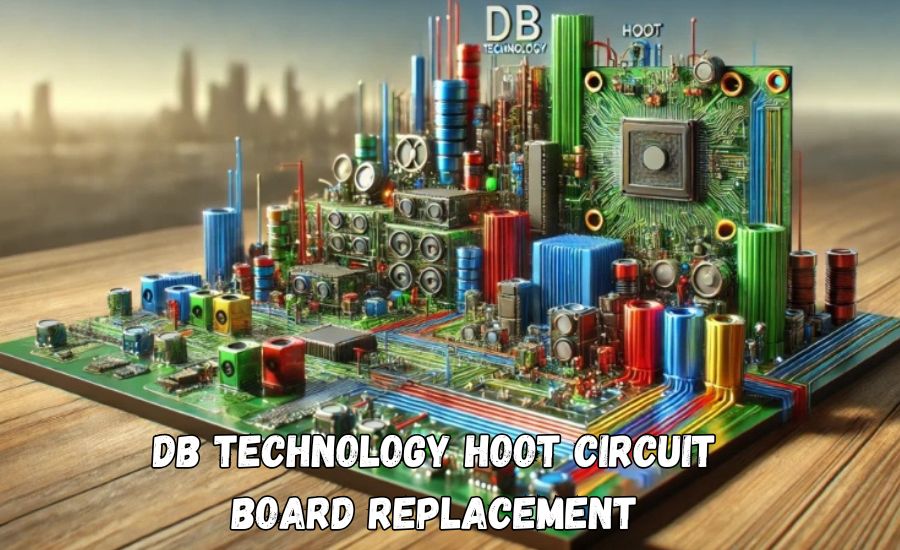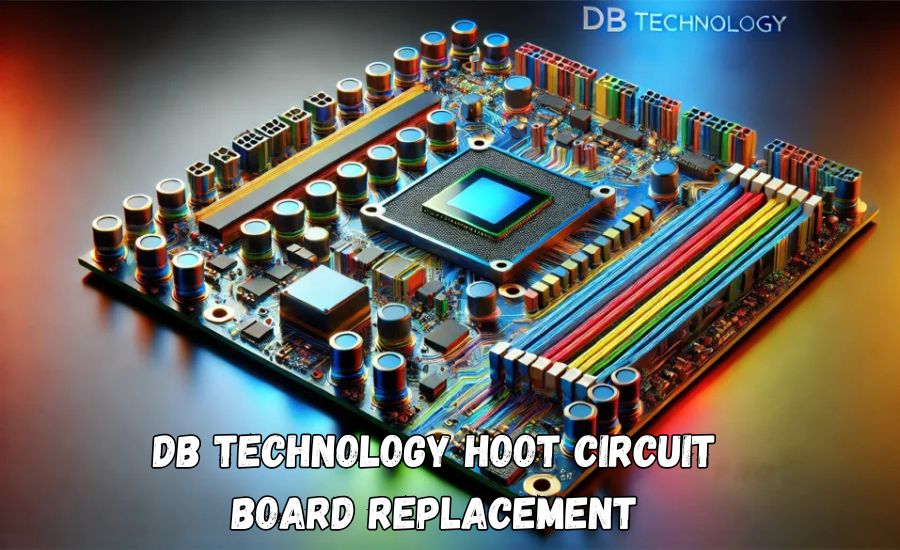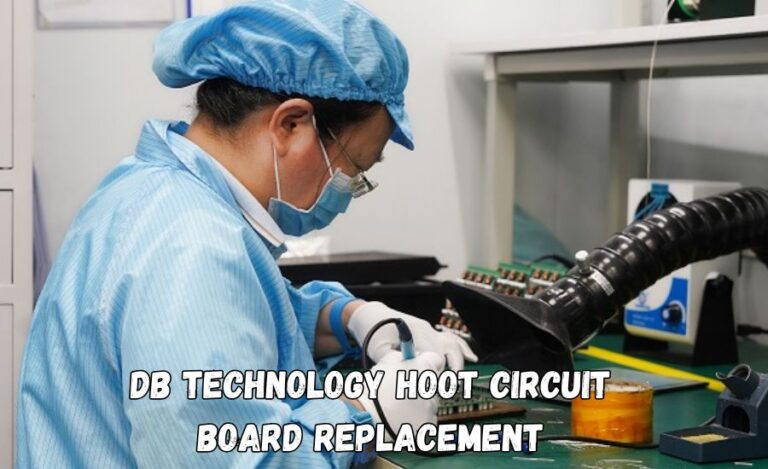As our world increasingly relies on technology, understanding the key components that power these devices becomes essential, especially for those who need to maintain and troubleshoot electronics. One such crucial component is the DB Technology Hoot circuit board. Whether you’re running a high-performance system, using a hot tub, or managing servers, your circuit board’s role is indispensable. When it starts to malfunction, it’s important to know how to replace it efficiently.
This article is designed to provide you with a comprehensive understanding of DB Technology Hoot circuit board replacement—why it’s necessary, the signs to look out for, and how to replace it step-by-step. With this guide, you’ll not only be able to address the issues at hand but also ensure that your systems are running optimally for years to come.
What is a DB Technology Hoot Circuit Board?
A DB Technology Hoot circuit board is a central part of various systems, from computing to home appliances and industrial equipment. It essentially acts as the system’s “brain,” processing data and managing the flow of electrical currents between different components. This board facilitates communication between multiple parts of the system, ensuring everything works harmoniously and efficiently.
Its role is especially critical in devices that require fast data processing or precise control, such as in industrial environments, servers, or even home spas. The board communicates commands, manages power distribution, and ensures that the entire device operates without interruption.
However, over time, even the most reliable circuit boards may face wear and tear. This can result from factors like environmental conditions (humidity, heat), electrical surges, or simple aging. When a DB Technology Hoot circuit board starts showing signs of failure, replacing it becomes essential to restore functionality and avoid damage to other parts of the system.
Why is DB Technology Hoot Circuit Board Replacement Important?

Circuit boards are vital for ensuring smooth operation across a range of devices. Without a functioning circuit board, your device could experience performance issues, slowdowns, or even complete failure. Here’s why replacing a faulty DB Technology Hoot circuit board is critical:
- Restores Device Functionality: A malfunctioning circuit board can cause severe issues, ranging from slow performance to complete shutdown. Replacing it ensures that your device regains full functionality, restoring its speed, efficiency, and effectiveness.
- Prevents System Overload: A faulty circuit board can lead to improper power distribution, which may result in overheating or damage to other internal components. Replacing it ensures that power is managed effectively, preventing overload and reducing the risk of permanent damage.
- Energy Efficiency: Older or damaged circuit boards tend to draw more power as they struggle to keep up with system demands. Replacing a worn-out board with a new one can improve your system’s energy efficiency, lowering electricity consumption and extending the device’s life.
- Avoids Costly Repairs: Continuing to operate a device with a faulty circuit board may lead to additional damages, which can result in more expensive repairs down the line. Replacing the board early on can save both time and money in the long run.
- Enhances Safety: Circuit boards are critical for managing electrical currents. A malfunctioning board can lead to shorts, overheating, or even fires in extreme cases. Replacing it promptly ensures that your system runs safely, reducing any risks associated with electrical malfunctions.
How to Identify a Failing DB Technology Hoot Circuit Board
Identifying the early signs of a malfunctioning DB Technology Hoot circuit board can save you from system failures and more expensive repairs. Here are some common indicators that it may be time to replace your circuit board:
1. Erratic Performance or Frequent Crashes
When your device begins to act unpredictably—shutting down suddenly, rebooting without prompt, or freezing—it’s a clear sign that something is wrong. These issues are often linked to a malfunctioning circuit board, particularly if the device becomes increasingly unstable over time.
2. Visible Damage on the Circuit Board
Physical inspection of the circuit board can reveal signs of damage, such as burn marks, corrosion, or broken components. These indicate that electrical surges or overheating have compromised the board, and immediate replacement may be necessary to prevent further damage.
3. Overheating and Unusual Noises
If your device is frequently overheating or you hear buzzing, clicking, or other unusual sounds, the circuit board could be to blame. These issues are often caused by faulty components on the board that are no longer regulating power or data flow correctly.
4. Error Messages or System Alerts
When devices start displaying error codes or system alerts related to power distribution or data communication, it’s likely that the circuit board is failing. While some errors can be resolved with software fixes, persistent issues are often due to hardware failures.
5. Failure to Power On
A complete failure to power on is often a sign of severe circuit board damage. If your device refuses to start or shuts down immediately after powering on, the DB Technology Hoot circuit board may need to be replaced.
Step-by-Step Guide to Replacing a DB Technology Hoot Circuit Board
While replacing a circuit board might seem complex, it can be straightforward with the right tools and approach. Follow these steps to replace your DB Technology Hoot circuit board safely:
Tools You Will Need:
- Screwdrivers: A set of magnetic screwdrivers is ideal to avoid losing small screws.
- Soldering Iron: Essential for connecting and disconnecting components securely.
- Multimeter: For testing electrical connections and ensuring the board is receiving the right voltage.
- Anti-Static Wrist Strap: To prevent damaging sensitive electronics through static electricity.
- Thermal Paste: If your board requires heat dissipation, applying thermal paste will help manage overheating.
1. Power Down and Unplug the Device
Before you begin, ensure that the device is completely powered down and unplugged from any power sources. This is essential for avoiding electric shock and protecting the internal components.
2. Open the Device and Locate the Circuit Board
Using the appropriate screwdriver, remove the cover of the device. Once inside, locate the DB Technology Hoot circuit board. Be cautious while handling other components to prevent accidental damage.
3. Take Note of Wiring Connections
Before disconnecting the circuit board, take detailed photos of the wiring and connections. This will serve as a reference when you install the new board, ensuring that all components are connected properly.
4. Disconnect the Old Circuit Board
Carefully disconnect the wires, harnesses, and any connectors attached to the old circuit board. Use pliers if necessary to loosen stubborn connectors without damaging the wires. Unscrew the board from its mount and gently lift it out of the device.
5. Install the New Circuit Board
Position the new DB Technology Hoot circuit board in the same location as the old one. Use the screws you removed earlier to secure it in place. Then, reconnect all wiring, making sure everything is attached firmly but without applying too much pressure.
6. Test the Device
Before reassembling the device, power it on to check if the new circuit board is functioning correctly. Test all of the system’s key functions to ensure that the board is performing as expected.
7. Close the Device and Perform Final Tests
Once you’ve confirmed that the new circuit board is working properly, close the device and perform a final series of tests to ensure everything is in order. Pay attention to any error messages or performance issues that may arise.
Common Mistakes to Avoid During Circuit Board Replacement
Replacing a circuit board requires attention to detail. Here are some common mistakes to avoid:
- Skipping Diagnostic Tests: Always test the old circuit board thoroughly before deciding to replace it. In some cases, the problem may not lie with the board, and unnecessary replacement could be costly.
- Forgetting to Ground Yourself: Static electricity can easily damage sensitive electronics. Always wear an anti-static wrist strap while handling the circuit board.
- Over-tightening Screws: Tightening screws too much can crack the board or other delicate components. Ensure they are secure, but don’t apply excessive force.
- Incorrect Wiring: Failing to document the wiring properly before disconnecting the old board can lead to incorrect connections when installing the new one. Always take photos for reference.
Read Also: Gaming-Console-Repair-Near-Me
Alternatives to Full Circuit Board Replacement

In some cases, you may not need to replace the entire circuit board. Here are a few alternatives:
- Component-Level Repairs: If only certain components, such as capacitors or resistors, are damaged, you can replace those specific parts without swapping out the entire board.
- Refurbished Boards: If budget is a concern, purchasing a refurbished DB Technology Hoot circuit board might be a viable option. Ensure it has been tested and comes with a warranty.
- Professional Repair Services: If you’re not comfortable replacing the circuit board yourself, you can hire a professional service to diagnose and repair the board. This may be more affordable than purchasing a brand-new board.
Maintaining Your New DB Technology Hoot Circuit Board
Once you’ve replaced the circuit board, proper maintenance is key to ensuring long-lasting performance. Here are a few tips:
- Keep the Device Clean: Dust and debris can accumulate inside the device and affect the circuit board’s performance. Regularly clean the device to prevent buildup.
- Check for Corrosion: Periodically inspect the circuit board for signs of corrosion, especially around the connectors. Clean any corrosion immediately to prevent further damage.
Ensure Adequate Ventilation: Proper airflow is essential for preventing overheating. Ensure your device has enough ventilation, and clean any dust from fans or vents.
- Use Surge Protectors: Power surges can cause severe damage to circuit boards. Always use surge protectors to shield your devices from electrical spikes.
Conclusion
The DB Technology Hoot circuit board is a critical component in a wide range of electronic systems, and replacing it when it begins to malfunction is crucial for maintaining optimal performance. By recognizing the signs of a failing board, gathering the right tools, and following the step-by-step replacement process outlined in this guide, you can ensure that your device runs smoothly and efficiently.
Regular maintenance and proactive repairs will also help extend the lifespan of your circuit board, ensuring your system remains reliable and efficient. Whether you opt for a full replacement or explore alternatives, understanding how to handle your DB Technology Hoot circuit board ensures you are prepared to keep your systems running at their best.
FAQs:
Q: What is a DB Technology Hoot circuit board?
A: The DB Technology Hoot circuit board is a key component in electronic devices, managing power distribution and data flow to ensure smooth operation.
Q: How can I tell if my DB Technology Hoot circuit board needs replacement?
A: Signs include frequent system crashes, overheating, visible damage, and unusual noises from the device.
Q: Can I replace the DB Technology Hoot circuit board myself?
A: Yes, with the right tools and guidance, you can replace the circuit board, but professional help is recommended if you’re unsure.
Q: How much does it cost to replace a DB Technology Hoot circuit board?
A: The cost ranges between $200 and $600 for the board, with additional labor costs if you hire a professional.
Q: What should I do after replacing the circuit board?
A: After replacing it, test the device for functionality, ensure proper ventilation, and maintain the system regularly to prolong its life.
Stay informed with the latest news and updates on Dallasinsiders.com
